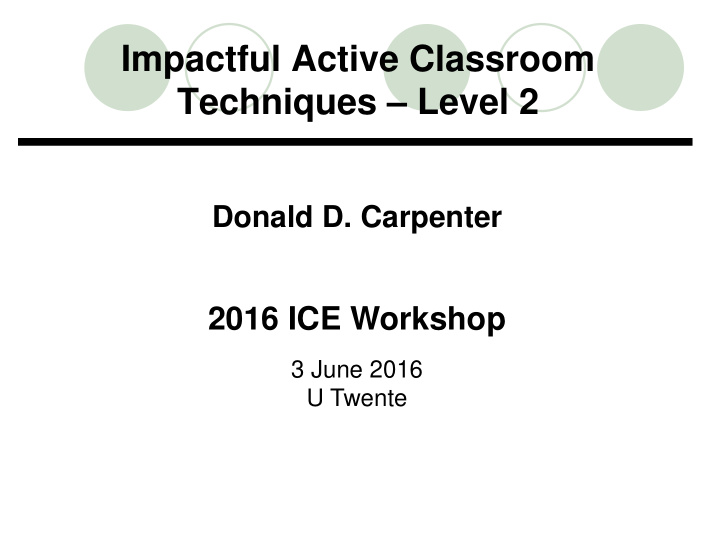



Impactful Active Classroom Techniques – Level 2 Donald D. Carpenter 2016 ICE Workshop 3 June 2016 U Twente
Active and Collaborative Learning (Levels 1-2 informal; Level 3 formal) Level 1 – easy, high-impact, low-effort • Think Pair Share • Think Pair Write Share • Quick Thinks • Minute Paper/Muddiest Point Level 2 – more prep time, medium effort • Rank Order • IF*AT (immediate feedback readiness test) • IRAT/GRAT (individual/group readiness assessment test) Level 3 – even more prep, restructuring of class time, can be deep impact • Jigsaw • Cooperative Base Pairs • Gallery Walk • Constructive Subject-related Debate/Controversy • Peer composition/editing
IF*AT • IF*AT – Instant Feedback Assessment Technique • An exciting and revolutionary testing system that transforms traditional multiple-choice testing into an interactive learning opportunity for students and a more informative assessment opportunity for teachers. http://www.epsteineducation.com/home/about/default.aspx
IF*AT Instructions • The IF*AT can be used for individual student assessment, or… • First, take the quiz ON YOUR OWN. • Answer the questions, but also rank how sure you are of your answer! 1) A 100% 2) D 50% 3) E 66%
IF*AT Instructions • After individual effort, the IF-AT becomes a GRAT (Group Readiness Assessment Technique) • Your group must reach consensus on a response before scratching off its covering. • NO, you cannot see through the card by holding it up to the light. • NO, you cannot just scratch off a tiny part of a box to search for the star. They are staggered.
IF*AT Instructions
IF*AT Instructions • Correct on first try (four scratches left): 5 points • Correct on second try (three scratches left): 3 points • Correct on the third try (two scratch left): 2 points • Correct on the fourth try (one scratch left): 1 point • No correct answer after fourth try: 0 points • Students hand in the form as a team.
Let’s Try One
More About the IF*AT • These also come in 4 answer cards with more than 10 questions. • Alter points of 4 answer cards (e.g., 4, 2, 1, 0) • The bottom can be torn off so that the students do not know what form is being used.
Key Benefits for Students Immediate Feedback Improved Learning and Retention More Accurate Assessment Active Learning & Better Test-Taking Engaging and Fun Reduces Test Anxiety http://www.epsteineducation.com/home/about/benefits.aspx
Key Benefits for Instructors • More Informative to Instructors • Communicates Respect for Learning • Makes "Building" Questions More Fair http://www.epsteineducation.com/home/about/benefits.aspx
IF*AT Testimonial “The IF-AT is an important component of our Team-Based Learning approach. The immediacy of the feedback allows team members quickly to correct their misconceptions of the subject matter and, even more importantly, learn how to work together effectively. The IF-AT virtually eliminates the problem of one or two members dominating team discussions. ‘Pushy’ members are only one scratch away from having to ‘eat crow’ and quiet members are one scratch away from being validated and 2 scratches away from being told that they need to speak up. The impact of the IF-AT on student learning is dramatic, as rooms often fill with cheers and high fives when correct answers are identified – and moans when answers are missed.” - Larry Michaelsen, Ph.D. Central Missouri State University - Dee Fink, Ph.D. University of Oklahoma
IF*AT Testimonial “I have found the IF-AT form to be a wonderful contribution to my use of Team-Based Learning in the classroom. Because the students get feedback about their responses immediately and are able to celebrate or mourn their choices as a group, team cohesion is greatly supported. As a result, the commitment to the group and their preparation for the tests are, I believe, very much enhanced. Together, the IF-AT and Team- Based Learning have played an important role in the growth of my elective course from an enrollment of 25 to over 400 students.” - Jane Connor, Ph.D., Assoc. Prof. of Human Development, Binghamton University
Recommend
More recommend